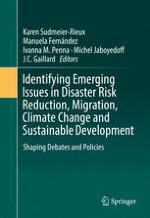The goal of this book is to explore disaster risk reduction (DRR), migration, climate change adaptation (CCA) and sustainable development linkages from a number of different geographical, social and natural science angles. Well-known scientists and practitioners present different perspectives regarding these inter-linkages from around the world, with theoretical discussions as well as field observations. This publication contributes in particular to the discussion on the Sendai Framework for Disaster Risk Reduction (SFDRR) 2015-2030 and the debate about how to improve DRR, including CCA, policies and practices, taking into account migration processes from a large perspective where both natural and social factors are crucial and mutually “alloyed”. Some authors see the SFDRR as a positive step forward in terms of embracing a multitude of issues, others doubting that the agreement will lead to much concrete action toward real action on the ground. This book is a timely contribution for researchers, students and policy makers in the fields of environment, human geography, migration, disaster and climate change studies who seek a more comprehensive grasp of contemporary development issues.
